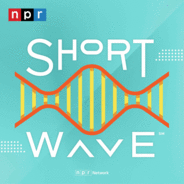For hundreds of years sailors have told stories about miles of glowing ocean during moonless nights. This phenomenon is known as "milky seas," but the only scientific sample was collected in 1985. So atmospheric scientist Justin Hudson, a PhD candidate at Colorado State University, used accounts spanning 400 years to create a database of milky seas. By also using satellite images to visually confirm the tales, Justin hopes his research brings us one step closer to unraveling this maritime mystery. Listen to every episode of Short Wave sponsor-free and support our work at NPR by signing up for Short Wave+ at plus.npr.org/shortwave.Got a question about a scientific mystery? Let us know at shortwave@npr.org. Learn more about sponsor message choices: podcastchoices.com/adchoicesNPR Privacy Policy

Wissenschaft & Technik
Short Wave Folgen
New discoveries, everyday mysteries, and the science behind the headlines — in just under 15 minutes. It's science for everyone, using a lot of creativity and a little humor. Join hosts Emily Kwong and Regina Barber for science on a different wavelength.If you're hooked, try Short Wave Plus. Your subscription supports the show and unlocks a sponsor-free feed. Learn more at plus.npr.org/shortwave
Folgen von Short Wave
1405 Folgen
-
Folge vom 02.06.2025Solving A Centuries Old Maritime Mystery
-
Folge vom 30.05.2025Why Daylight Boosts ImmunityDepending on what time it is, your body responds differently to an injury or infection. During the day, you're likely to heal faster and fight infection better than at night. And historically, scientists weren't entirely sure why. That picture is starting to clear up thanks to a new study published last week in the journal Science Immunology. The research finds a missing piece of the puzzle in neutrophils, powerful immune cells that — despite living less than 24 hours — know the difference between day and night.Got a question about how the body works? Let us know at shortwave@npr.org. Listen to every episode of Short Wave sponsor-free and support our work at NPR by signing up for Short Wave+ at plus.npr.org/shortwave.Learn more about sponsor message choices: podcastchoices.com/adchoicesNPR Privacy Policy
-
Folge vom 28.05.2025Unpacking Bipolar DisorderAround 40 million people around the world have bipolar disorder, which involves cyclical swings between moods: from depression to mania. Kay Redfield Jamison is one of those people. She's also a professor of psychiatry at the Johns Hopkins School of Medicine and has written extensively about the topic, from medical textbooks to personal memoirs. Today on Short Wave, she joins us to talk about the diagnosis process, treating and managing bipolar disorder. Listen to every episode of Short Wave sponsor-free and support our work at NPR by signing up for Short Wave+ at plus.npr.org/shortwave.Got a question about mental health? Let us know at shortwave@npr.org. Learn more about sponsor message choices: podcastchoices.com/adchoicesNPR Privacy Policy
-
Folge vom 27.05.2025Nature Quest: The Climate-Kid QuestionGen Z and younger millennials are the most climate literate generations the world has ever seen. They learned about climate change in school; now, it's part of how they plan for the future, including for jobs, housing ... and kids.So, what do experts say about how to navigate the kid question? In this installment of Nature Quest, Short Wave speaks to climate journalist Alessandra Ram about the future she sees for her newborn daughter. Plus, how do we raise the next generation in a way that's good for the planet? Resources discussed in this episode include:Jade Sasser's book, Climate Anxiety and the Kid QuestionKimberly Nicholas's High Impact Climate Action GuideElizabeth Bechard's book, Parenting in a Changing ClimateThe Climate Mental Health Network's Climate Emotions WheelGot a question about changes in your local environment? Send a voice memo to shortwave@npr.org with your name, where you live and your question. You might make it into our next Nature Quest episode!Learn more about sponsor message choices: podcastchoices.com/adchoicesNPR Privacy Policy
